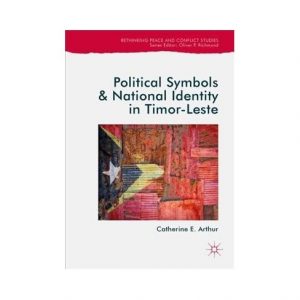Political Symbols: Representing Kaleidoscope Nations
This blog was written by Dr. Catherine Arthur, Lecturer in Humanitarian Studies. It summarises her recent book publication: Political Symbols and National Identity in Timor-Leste.
Symbols of identity – flags, hero figures, emblems of nationhood – are the central glue that binds diverse nations together, but which are often overlooked in research on nation-building. People go to war under flags, cry during their national anthem, dedicate national holidays to their heroes, and create their own sense of identity at an individual level based. Symbols enable us to feel connected to strangers who share in our culture, history, and heritage, and give shape and form to those abstracts of our identities that cannot be put into words. Symbols perform a vital role as the umbrellas under which heterogenous nations come together and identify, especially in post-conflict, transitional societies that undergo processes of nation-building.
Within a context of post-colonial, post-conflict nation-building, the importance of political symbols in nation-building and national identity formation cannot be underestimated. The very fact of colonialism brings with it complexities of identity, language, and cultural heritage, and inevitable aspects of hybridity (Bhabha 1994). Different imaginings of nationhood, and experiences of a colonial past can present significant challenges to fostering a unified national identity, and therefore to nation-building itself. In societies that undergo transition from a state of conflict equally experience challenges to fostering widespread unity, particularly those regions that have experienced civil war, local ethnic conflict, and state terror and violence. In such contexts of potential division, the unifying function of symbols is critical as it allows a plethora of imaginings of identity to join under one visual object. If one flag can bring groups and individuals together, where previously there had been bitter conflict, then it performs a central role in sustaining nationhood. It is for this reason that identity symbols are deserving of more attention in studies of nation-building and national identity formation. Timor-Leste is one of the youngest nation-states in the world and, after only sixteen years of self-determination, is still in the process of nation-building. In 2002, Timor-Leste regained independence, after 450 years of Portuguese colonialism and a brutal 24-year military occupation by Indonesia, and state- and nation-building formally began. Considering the multiple layers of colonial legacies that have influenced ‘East Timorese-ness’, an analysis of political symbols within the context of post-independence nation-building deepens our understanding of national identity formation complexities, and considers both top-down and bottom-up agency. Moreover, visual representations of identity take on a heightened importance in Timor-Leste as a result of persistently low literacy levels; the total adult literacy rates from 2008 to 2012 were estimated to be around 58.3 per cent (see UNICEF 2013), further expounding their central importance. By analysing a range of symbols it is possible to see how an East Timorese national identity has formed, but also how it has been negotiated and re-imagined by different members of society. Identification is an ongoing process, and by speaking to East Timorese people about their identity symbols, it becomes clear that notions of ‘East Timorese-ness’ are fluid and constantly being reinterpreted in relation to ongoing social, economic, and political challenges.
Timor-Leste is one of the youngest nation-states in the world and, after only sixteen years of self-determination, is still in the process of nation-building. In 2002, Timor-Leste regained independence, after 450 years of Portuguese colonialism and a brutal 24-year military occupation by Indonesia, and state- and nation-building formally began. Considering the multiple layers of colonial legacies that have influenced ‘East Timorese-ness’, an analysis of political symbols within the context of post-independence nation-building deepens our understanding of national identity formation complexities, and considers both top-down and bottom-up agency. Moreover, visual representations of identity take on a heightened importance in Timor-Leste as a result of persistently low literacy levels; the total adult literacy rates from 2008 to 2012 were estimated to be around 58.3 per cent (see UNICEF 2013), further expounding their central importance. By analysing a range of symbols it is possible to see how an East Timorese national identity has formed, but also how it has been negotiated and re-imagined by different members of society. Identification is an ongoing process, and by speaking to East Timorese people about their identity symbols, it becomes clear that notions of ‘East Timorese-ness’ are fluid and constantly being reinterpreted in relation to ongoing social, economic, and political challenges.


0 Comments